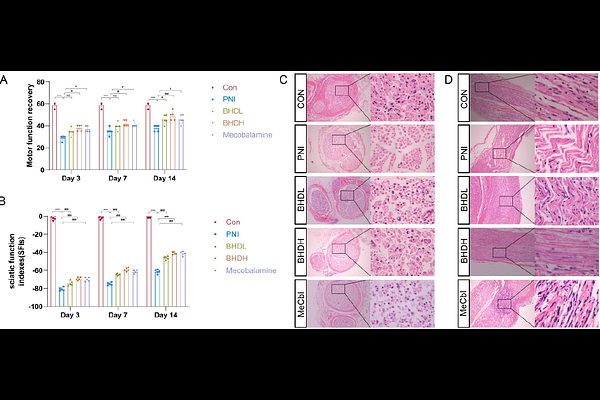Buyang Huanwu Decoction Ameliorates Peripheral Nerve Injury by Promoting Cell Cycle through Activation of PI3K/AKT/mTOR/HIF-1α Pathway

Buyang Huanwu Decoction Ameliorates Peripheral Nerve Injury by Promoting Cell Cycle through Activation of PI3K/AKT/mTOR/HIF-1α Pathway
Li, H.; Zhou, X.; Huang, P.; Zhang, X.; Gao, Y.; Fu, B.
AbstractBackground: Peripheral nerve injury (PNI) can lead to partial or even total motor and sensory dysfunction, severely affecting the work and life of patients, but recovery of nerve function is often poor due to the complexity of the nerve repair and regeneration process. Cumulative evidence suggests the contribution of cell cycle regulation in repairing PNI injury, and p27KIP1 is a key molecule in regulating the cell cycle. Objective: The aim of this study is to elucidate the repair mechanism of peripheral nerve injury (PNI) from the point of view of regulating cell cycle and to explore the therapeutic effect of Buyang Huanwu Decoction (BHD). To provide new strategies for the treatment of PNI and to explore valuable drugs initially. Methods: The clamp injury model was chose as a PNI model and different doses of BHD extract were administered by gavage for 14 days. Limb motor function, sciatic nerve index and sciatic nerve pathology were assessed and p27Kip expression level was determined. The in vivo chemical composition of BHD extract was determined and drug targets were retrieved by TCMSP, STITCH and Swiss Target Prediction to predict the mechanism of BHD treatment for PNI using network pharmacology. Pathway-related proteins including P-PI3K, P-AKT, P-mTOR and HIF-1a were validated by western blotting assay. Results: Compared with control rats, PNI rats had abnormal motor function, sciatic nerve damage and reduced p27Kip expression. Administration of BHD for 14 days significantly improved PNI in rats, which not only repaired sciatic nerve function, attenuated sciatic nerve pathology and inhibited p27Kip expression to regulate the cell cycle in PNI rats, but also activated the PI3K/AKT/mTOR/HIF-1a pathway. Conclusion: The above results suggest that PI3K/AKT/mTOR/HIF-1a mediated cell cycle regulation may be an important repair mechanism for PNI, and that BHD can improve PNI by accelerating the cell cycle to promote neural repair and regeneration.